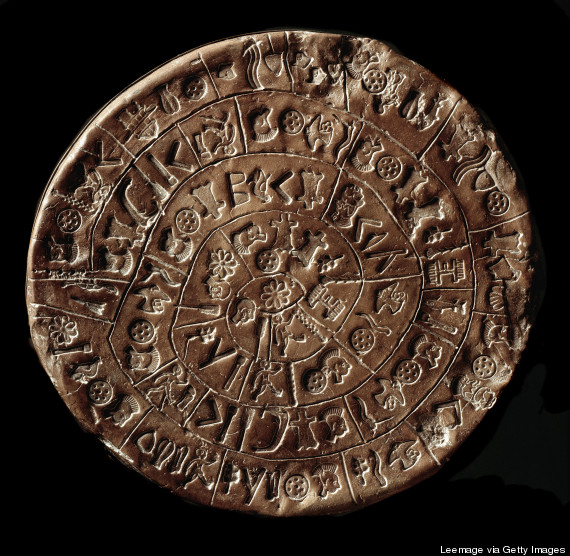A century of puzzling
Believed to be the world’s first printed document, the Phaistos Disc was unearthed 100 years ago.
Andrew Robinson | June 2008 [Nature, Volume 453, no. 19]
The Rosetta Stone is the most famous of ancient inscriptions; it unlocked the meaning of thousands of Egyptian hieroglyphic inscriptions. The undeciphered Phaistos Disc, discovered by an Italian archaeologist at Phaistos near the coast of southern Crete a century ago next month, is perhaps the most infamous. Luigi Pernier found the disc on 3 July 1908 in a basement cell of a ruined Minoan palace dating from the first half of the second millennium B.C. No other samples of the script have turned up since. Pernier published his find in 1909 without trying to decipher it.
 |
| The front of the Phaistos disk, which is 16 centimeters in diameter. Source: http://www.huffingtonpost.com/2014/10/28/ancient-cd-rom-phaistos-disk-code_n_6055178.html. |
 |
| Back of disk. Source: http://www.huffingtonpost.com/2014/10/28/ancient-cd-rom-phaistos-disk-code_n_6055178.html |
<more at http://www.nature.com/articles/453990a.epdf?referrer_access_token=fuEO5nZBMNTWVRzz0jISydRgN0jAjWel9jnR3ZoTv0MXmJBboTioNxl2aM9hkiWIdqwk7YE_QHaQ3km6LrXZ_lWevUyj-j8viM3zr_ypBPaSFUS6CXFCbhqutmqlxRrX92tA23vrzYpQDqsHDGl1c4xROGI4mfXrUUC9OZBAYCgBpe5KCYIdy1ekvzvhDnHCrwq0afJQqSDUT2cBbP4r8w%3D%3D&tracking_referrer=www.nature.com; related link: http://www.huffingtonpost.com/2014/10/28/ancient-cd-rom-phaistos-disk-code_n_6055178.html (Scientists Finally Crack The Code Of The Ancient 'Phaistos Disk'. (+ Video, TED Talk) October 28, 2014) and http://www.teicrete.gr/daidalika/pages/page.php?page=phaistos_disk (The Phaistos Disk and Related Inscriptions)>

No comments:
Post a Comment